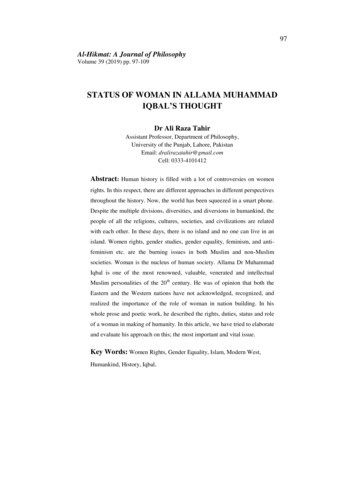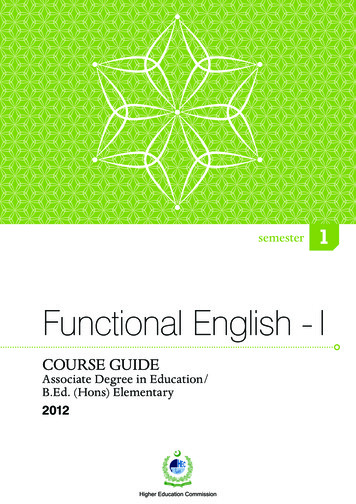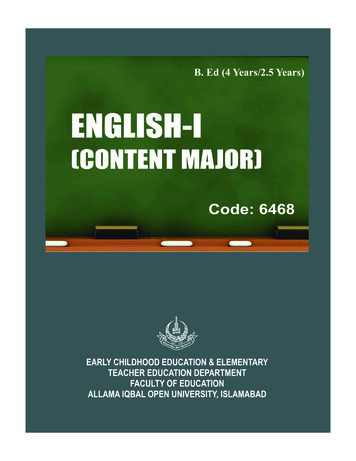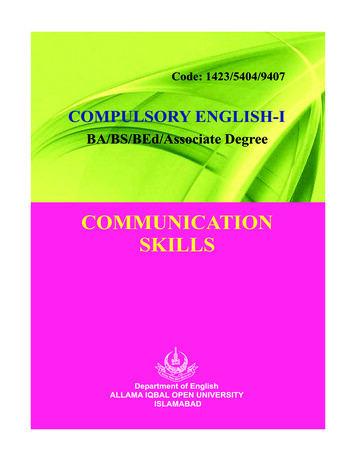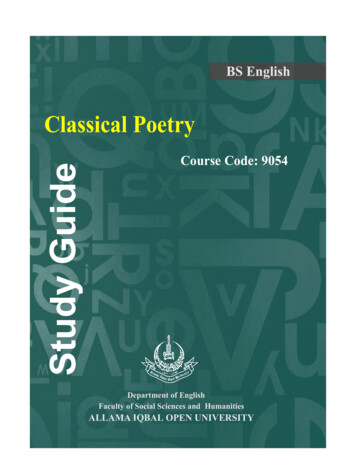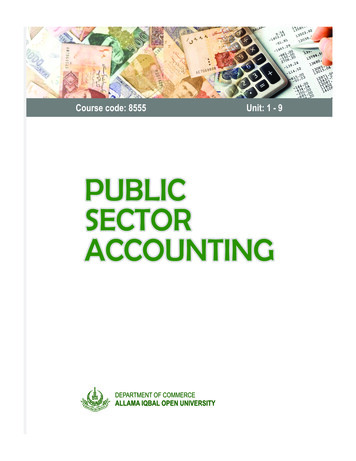
Transcription
PUBLIC SECTOR ACCOUNTINGCourse Code: 8555Units: 1–9DEPARTMENT OF COMMERCEALLAMA IQBAL OPEN UNIVERSITY, ISLAMABADi
DISCLAIMERThe contents of this book contain certain sections from the Manual of AccountingPrinciples and Manual of Accounting Procedures issued by the Office of Auditor Generalof Pakistan and other guides/resources available on the website of various governmentdepartments. The objective of this book is to enable students to understand the system ofpublic sector accounting in Pakistan.(All Rights are Reserved with the Publisher)Year of Printing.2018Quantity .1000Layout by .Muhammad JavedPrinter .Allama Iqbal Open UniversityPublisher .Allama Iqbal Open University, Islamabadii
COURSE TEAMDean F/O. SS&H:Prof. Dr. Samina AwanChairman Department of Commerce :Dr. Syed Muhammad Amir ShahCourse Coordinator:Moazzam AliCourse Team:1. Moazzam AliAssistant Professor,Department of Commerce2. Asia BatoolResearch Associate3. Muneeba AshrafResearch AssistantEditor:Fazal Karimiii
COURSE INTRODUCTIONThe Public Sector Accounting principles are used in the government sector organizations.Unlike the traditional financial accounting model used by the corporate entities, thepublic sector accounting involves different concepts and formats for presentation offinancial data. This book is based on the Manual of Accounting Principles and Manual ofAccounting Procedures developed by the office of Auditor General of Pakistan. Theobjective of this course is to familiarize students with the working of the public sectoraccounting system in Pakistan.The unit one presents purpose and structure of the manual of accounting principles andcore concepts of public sector accounting model, internal control and budgeting. The unittwo describes the accounting period, accounting record and accounting elements toclarify how accounting records are maintained in the public sector bodies.In unit three financial and accounting responsibilities of Public Accounts Committee,Auditor General’s Office, Accountants General’s Office, Ministry of Finance, FederalBoard of Revenues, State Bank of Pakistan and centralized accounting entities have beenexplained to clarify the functions of these departments.In unit four, the organizational structure of the accounting system will be discussed toexplain the key responsibilities of accounting system and concepts of budgetary controlhas been elaborated.In unit five, the focus will be on the treatment of expenditures and their accountingpolicies. In unit six we will study the general accounting policies & procedures for thetreatment of receipts in government sector entities.The unit seven prescribes the financial reporting procedures and their general policies. Italso includes treatment of loss and recoveries of public money. In unit eight, a specialattention has been given to the self accounting entities and its general policies. Lastly, inunit nine, various categories of liabilities & their treatment in public sector accountinghave been discussed.Errors and omissions are expected as writing is a continues exercise of improving thesubject matter. Kindly inform us about such discrepancies and put forward valuablesuggestions.Moazzam AliAsst. Prof./Course CoordinatorDeptt. Of Commerce, AIOU,IslamabadMoazzam.ali@aiou.edu.pkiv
CONTENTSSr. No.TitlesPage No.UNIT 1 MANUAL OF ACCOUNTING PRINCIPLES I . 01Introduction . 04Objectives. 041.1 Purpose of the Manual . 051.2 Structure of the Manual. 061.3 Authority, Applicability, Distribution and Maintenance of the Manual . 061.4 Accounting Concepts . 081.5 Accounting Model . 131.6 Internal Control. 181.7 Budgeting . 19Summary . 22UNIT 2 MANUAL OF ACCOUNTING PRINCIPLES II. 23Introduction . 25Objectives. 252.1 Accounting Period . 262.2 Accounting Records. 262.3 Accounting Elements . 272.4 Banking . 332.5 Reporting. 352.6 Inter Entity Transactions . 37Summary . 38UNIT 3 MANUAL OF ACCOUNTING PRINCIPLES III . 39Introduction . 42Objectives. 423.1 Financial and Accounting Responsibilities of the Public AccountsCommittee . 433.2 Financial and Accounting Responsibilities of the Auditor-General’sOffice . 433.3 Financial and Accounting Responsibilities of the Accountants-Generals’Offices . 443.4 Financial and Accounting Responsibilities of the Ministry of Finance . 453.5 Financial and Accounting Responsibilities of the Central Board ofRevenue. 463.6 Financial and Accounting Responsibilities of the State Bank of Pakistan . 46v
3.7Financial and Accounting Responsibilities of centralized accountingentities . 473.8 Financial and Accounting Responsibilities of Schedule 1 entities . 473.9 Financial and Accounting Responsibilities of Principal AccountingOfficers. 473.10 Financial and Accounting Responsibilities of Internal Audit Officer. 483.11 Financial and Accounting Responsibilities of Auditor-General ofPakistan . 49Summary . 50UNIT 4 ACCOUNTING POLICIES AND PROCEDURES MANUAL I. 51Introduction . 53Objectives. 534.1 Introduction . 544.2 Organizational Structure of the Accounting System. 544.3 The Accounting System . 584.4 Definitions . 614.5 Budgetary Control. 724.6 General Policies . 744.7 Detailed Procedures . 764.8 Specific Budgetary Procedures. 87Summary . 88UNIT 5 ACCOUNTING POLICIES AND PROCEDURES MANUAL II . 89Introduction . 94Objectives. 945.1. Expenditures . 955.2. General Policies . 965.3. Accounting Policies . 1015.4. Accounting for Expenditures. 1045.5. Detailed Procedures . 1095.6. Salaries and Wages . 1215.7. Pension Payments . 1305.8. General Provident Fund . 1405.9. Contractor/Work Payments . 1465.10. Loans And Advances . 1525.11. Overseas Payments . 1575.12. Grants-in-aid, Contributions etc . 1575.13. Assignment Account and Personal Ledger Account. 1595.14. Maintenance of Permanent Accounting Records. 159Summary . 162vi
UNIT 6 ACCOUNTING POLICIES AND PROCEDURES MANUAL III. 163Introduction . 166Objectives. 1666.1. Receipts . 1676.2. General Policies . 1676.3. Accounting Policies . 1706.4. Accounting for Receipts. 1726.5. Detailed Procedures . 1746.6. Treatment of Specific Classes of Receipt. 1816.7. Bank Reconciliation. 1836.8. General Policies . 1856.9. Daily Procedures. 1896.10. Monthly Procedures . 191Summary . 194UNIT 7 ACOUNTING POLICIES AND PROCEDURE MANUAL IV. 195Introduction . 198Objectives. 1987.1. Financial Reporting Procedures. 1997.2. General Policies . 1997.3. Year-end Accounting Policies . 2037.4. Detailed Procedure. 2047.5. Loss and Recoveries of Public Money . 2097.6. General Policies . 2097.7. Accounting for Losses and Recoveries . 211Summary . 214UNIT 8 ACCOUNTING POLICIES AND PROCEDURES MANUAL V . 215Introduction . 218Objectives. 2188.1. Self-accounting Entities . 2198.2. General Policies . 2218.3. Accounting Policies . 2218.4. Accounting for Self-accounting Entity Transactions . 2238.5. Detailed Procedures . 2238.6. Project Accounting . 2268.7. General Policies . 2268.8. Accounting Policies . 2288.9. Accounting for Project Expenditures . 229Summary . 232vii
UNIT 9 ACCOUNTING POLICIES AND PROCEDURES MANUAL VI . 233Introduction . 236Objectives. 2369.1 Accounting for Liabilities . 2379.2 General Policy . 2379.3 Categories of Liabilities . 2389.4 Accounting Policies . 2409.5 Accounting Procedures . 2419.6 Reconciliation of Liability Records . 2449.7 Reporting of Liabilities . 2459.8 Transactions Between Government Entities. 2469.9 General Policies . 2479.10 Accounting Policies . 2509.11 Accounting for Transactions between Government Entities . 2529.12 Detailed Procedures . 252Summary . 258viii
UNIT -1MANUAL OF ACCOUNTINGPRINCIPLES ICompiled by: Muneeba AshrafAsia BatoolReviewed by: Moazzam Ali1
CONTENTSSr. No.TitlesPage No.Introduction .Objective .04041.1. Purpose of the Manual .051.2. Structure of the Manual .1.2.1 Reader Guidance .06061.3. Authority, Applicability, Distribution and Maintenance of the Manual .1.3.1 Authority .1.3.2 Effective Date .1.3.3 Coverage .1.3.4 Compliance .1.3.5 Distribution, Maintenance and Update .1.3.6 Explanatory Note .060606070708081.4. Accounting Concepts .1.4.1 Consolidated Fund and Public Account .1.4.1.1 Introduction .1.4.1.2 Certain Funds and Accounts to be kept by Governments .1.4.1.3 Consolidated Fund .1.4.1.4 Public Account .1.4.1.5 Explanatory Note.080808080910111.5. Accounting Model .1.5.1 Introduction .1.5.2 Accounting Elements .1.5.3 Assets .1.5.4 Liabilities .1.5.5 Equity .1.5.6 Revenues .1.5.7 Expenses .13131313141414152
1.5.81.5.91.5.101.5.111.5.12Expenditure and Commitments .Double entry Book Keeping .Generally Accepted Accounting Principles (GAAP) .Classification of Transactions .Explanatory Note .15161616161.6. Internal Control .1.6.1 Introduction .1.6.2 Definition .1.6.3 Explanatory Note .181819191.7. Budgeting .1.7.1 Introduction .1.7.2 Submission of Estimates .1.7.3 Annual Budget Statement.1.7.4 Budget Statement Disclosure .1.7.5 Explanatory Note .1.7.6 The Budget Cycle .Summary.19192020202020223
INTRODUCTIONThis unit is a brief introduction of the accounting principles used in the public sectororganizations. Unlike the traditional financial accounting model used by the corporateentities, the public sector accounting involves different concepts and formats forpresentation of financial data. The authority, applicability, distribution and maintenanceof the public sector accounting records will be explained in detailed. The concept ofaccounting model, Consolidated Fund and Public Account will also be discussed in this unit.OBJECTIVESAfter studying this unit, you will be able;1.to know the structure of the Manual of Accounting Principles2.to elaborate the authority, applicability, distribution and maintenance of publicaccounts3.to discuss consolidated fund and public account4.to understand the concept of public accounting model4
1.1. Purpose of the Manuali.ii.iiii.iv.v.The purpose of this Manual is to: Set out the accounting principles to be used in accounting for the transactionsof centralized and self accounting entities within the control of the Federaland Provincial Governments. It excludes exempt entities as defined inschedule two of this manual. Outline the roles and accountability of specified organizations and officers ofthe centralized accounting and self accounting entitiesThis manual will cover the principles, policies and procedures in relation tocentralized accounting entities and will only lay down the principles for selfaccounting entities because the policies and procedures for self accounting entitiesare covered by their individual rules and regulations.This Manual defines the framework within which accounting transactions are to betreated and recorded, and accounting and financial responsibilities are to beassigned.Detailed accounting policies and procedures are contained in the AccountingPolicies and Procedures Manual. Reference should be made to the AccountingPolicies and Procedures Manual, Financial Reporting Manual, Chart of Accounts,Manual of External Reporting Requirements in determining the rules andprocedures for the treatment and recording of specific transactions.Documents relevant to accounting and financial management of centralizedaccounting and self accounting entities include:a)Chart of Accountsb)Delegation of Financial Power under the Financial Rulesc)Rules of Businessd)Accounting Policies and Procedures Manuale)General Financial Rulesf)Federal/Provincial Treasury Rulesg)Financial Reporting Manualh)Manual of External Reporting Requirements5
1.2. Structure of the Manual1.2.This Manual is in three parts.i.The first part of this Manual, comprising section 1, provides an overview ofthe purpose and scope of this Manual.ii.The second part of this Manual, comprising sections 2 and 3, sets out theaccounting principles to be used by centralized accounting and selfaccounting entities and upon which the detailed policies and procedurescontained in the Accounting Policies and Procedures Manual are based.iii. The third part of this Manual, comprising sections 4 and 5, outlines thefinancial and accounting responsibilities of specified organisations andfinancial officers.There are two Schedules attached to this Manual.i.Schedule 1 is a list of all self accounting entities.ii.Schedule 2 is a list of all exempt entities.1.2.1 Reader Guidance1.2.3.The organization of the sections, headings and sub headings is shown in the Tableof Contents at the front of this Manual.The layout of each page within this Manual is standardized. The title of the Manualand the name of the chapter are displayed in the top left and right corners of eachpage respectively. The footer for each page contains the issue date, page numberand file reference.Each section of this Manual has the principles appearing at the front of the section.Any detailed or additional explanation and guidance is contained in the“Explanatory notes” subsection. Principles should not be interpreted without firstmaking reference to the explanatory notes.1.3. Authority, Applicability, Distribution and Maintenance of the Manual1.3.1. AuthorityThis Manual is issued to set out the accounting principles in accordance with which theaccounts of the federation and the provinces shall be kept, in pursuance of article, 170 ofthe Constitution of Islamic Republic of Pakistan.1.3.2. Effective DateThe effective date for application of this Manual is the date of issue of the Manual by theAuditor-General.All accounting entities will have up to two financial years (commencing from Julysubsequent to the effective date of release) to be in full compliance with this Manual.6
1.3.3. CoverageAccounting EntityAn accounting entity is any unit of Government (e.g. ministry, division, and department),whose principal source of funding is an appropriation from the Federal and ProvincialGovernments, which prepares input to the accounting system and which is not defined inSchedule 2 of this Manual.There are two types of accounting entities, namely centralized accounting entities andself accounting entities.i.Centralized Accounting EntitiesA centralized accounting entity is any accounting entity for which the AccountantGeneral has primary responsibility for the accounting and reporting function of thatentity.Unless specifically stated otherwise the term accounting entity will include allcentralized accounting entities.ii.Self Accounting EntitiesA self accounting entity is any accounting entity for which the PrincipalAccounting Officer has primary responsibility for the accounting and reportingfunctions. A list of these entities is contained in Schedule 1 of this Manual.Unless specifically stated otherwise, the term accounting entity will include all selfaccounting entities.Exempt EntitiesAn exempt entity is any entity defined in Schedule 2 of this Manual.The term accounting entity excludes exempt entities.1.3.4. ComplianceCompliance with the Manual is mandatory for all accounting entities.In the event that a guideline in this Manual conflicts with other Manuals, directives orpractices, other than those amending this Manual, the guidance in this Manual will prevail.Accounting entities are not authorised to implement accounting principles in conflictwith, or contrary to, those set out in this Manual.Sections 5 and 6 covering the “Organization of Financial and AccountingResponsibilities” and the “Financial and Accounting Responsibilities of FinancialOfficers” provide specific guidance as to the accounting and financial managementresponsibilities of key organisations and financial officers.The guidance contained in sections 6 and 7 are in addition to, and in no way negate orreplace those responsibilities and account abilities contained in the Delegation ofFinancial Power under the Financial Rules, the Authorities Manual, the Rules of Businessand any other directives issued by a competent authority.7
1.3.5. Distribution, Maintenance and UpdateThe Auditor-General of Pakistan will be responsible for: the initial issue of the Manual toall Principal Accounting Officers of accounting entities the maintenance and update ofthe Manual, including distribution of any updates or amendments to all PrincipalAccounting Officers of accounting entities.For all accounting entities, the Principal Accounting Officer will ensure that: initialcopies of the Manual are distributed to all finance and account officers within theaccounting entity all subsequent updates and amendments of the Manual are distributedto all finance and accounts officers within the accounting entity.1.3.6. Explanatory NoteStatutory and Legal Requirement for ComplianceCompliance with the directives and principle s contained in this Manual are mandatory asthe principles and directives contained in this Manual have been issued under thePakistan (Audit and Accounts) Order 1973.The Pakistan (Audit and Accounts) Order 1973 provides that the Auditor-General will beresponsible for keeping the accounts of the Federation and of each Province, other thancertain specified entities. The Order is issued subsequent to Article 170 of theConstitution of the Islamic Republic of Pakistan which states that “the accounts of theFederation and of the Provinces shall be kept in such form and in accordance with suchprinciples and methods as the Auditor-General may, with the approval of the Presidentprescribe”.Note: The Pakistan Audit and Accounts Order 1973 will be substituted by “PakistanAudit and Accounts Act” when passed by the Parliament.1.4. Accounting Concepts1.4.1. Consolidated Fund and Public Account1.4.1.1 IntroductionThe purpose of this section is to define and detail the principles upon which theConsolidated Fund and Public Account are established and operate.1.4.1.2 Certain Funds and Accounts to be Kept by GovernmentsEach Provincial Government and the Federal Government will maintain a ConsolidatedFund and a Public Account.8
1.4.1.3 Consolidated FundDefinitionAll moneys received, all loans raised and all moneys received in repayment of any loanby the Government, will form the Consolidated Fund of the Government.Schedule of Authorized ExpenditureNo expenditures will be met from the Consolidated Fund unless specified in a dulyapproved “Schedule of Authorized Expenditure”.Consolidated Fund1.Revenue Receipts - Direct TaxesIncome Tax- includes personal and company income taxes. The procedures forincome tax assessment and collection are regulated und
financial data. This book is based on the Manual of Accounting Principles and Manual of Accounting Procedures developed by the office of Auditor General of Pakistan. The objective of this course is to familiarize students with the working of the public sector accounting system in Pakistan.
